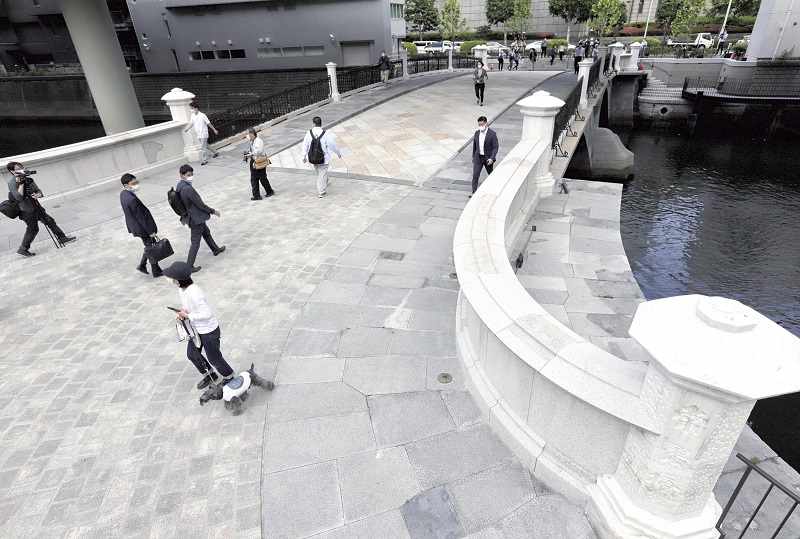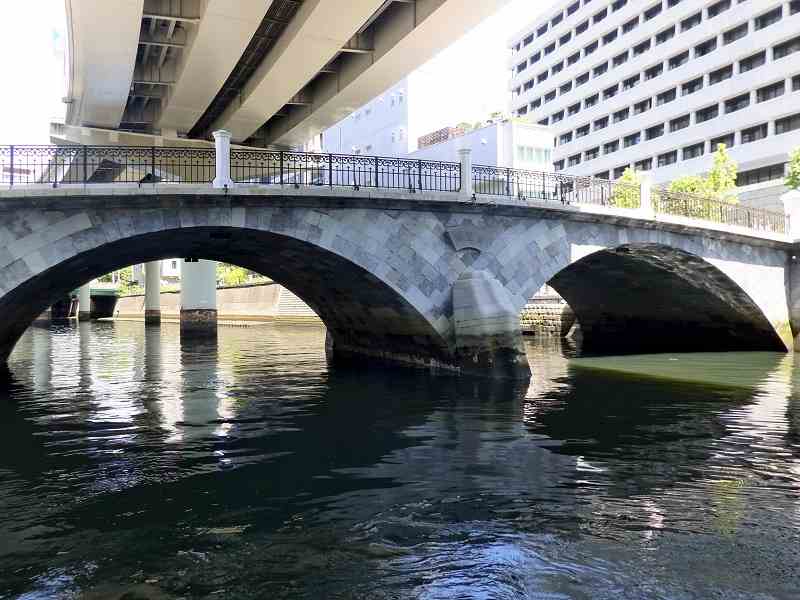
People walk on the Tokiwa Bridge in Chiyoda Ward, Tokyo, on May 10 following it’s reopening for pedestrian traffic.
12:17 JST, May 17, 2021
After a decade of restoration work, Tokyo’s oldest stone bridge outside of gardens is open again for pedestrians.
The Tokiwa Bridge, which crosses the Nihombashi River between Chiyoda and Chuo wards, had been undergoing repairs from damage it suffered in the Great East Japan Earthquake. The bridge was reopened for pedestrians on May 10.
According to Chiyoda Ward, the bridge was originally a wooden structure that was rebuilt in stone in 1877.
Much of the restoration work had to be done by hand in order to renew the bridge’s appearance as it was during the period of Japan’s modernization, which began at the outset of the Meiji era (1868-1912).
The bridge, which is 28.8 meters long and 12.6 meters wide, and the area around it have been designated as a national historic site called the Ruins of the Tokiwabashi Gate. It suffered severe damage in the Great Kanto Earthquake of 1923, and after renovations were completed in 1934, became a cherished centerpiece of Tokyo’s business district as a pleasant walkway.
The Great East Japan Earthquake in March 2011 left the bridge highly unstable and in danger of collapse, and it was blocked off to pedestrians.
The restoration began in December of that year. The original locations of all of the approximately 5,000 stones used in the bridge were recorded, and artisans used that information in restacking the stones. Preparing for possible restoration again someday, the surface of the stones were coated with Japanese paper as they were stacked to make future removal easier.
During the repair process, it was discovered that some of the stones had once been part of the stone wall of the Koishikawa-mon Gate of Edo Castle.
Old photographs and other reference materials were used to restore the cutwater in the central portion of the bridge and the arabesque handrails. While the bridge is now limited to pedestrians, at the time it was built horse-drawn carriages passed over it. As such, the bridge was divided into sidewalk and roadway, and that aspect was also faithfully reproduced.

The restored Tokiwa Bridge, as seen from the Nihombashi River on May 10
“In order to protect the cultural value of the oldest stone bridge in Tokyo, we aimed to restore it to its original state,” emphasized Koichi Sakamaki, chief of Chiyoda Ward’s roads and parks division.
The repair work, which was carried out by stone craftsmen specializing in cultural properties and is said to have cost about ¥3.6 billion, was originally scheduled to be completed by March 2018. But it was greatly delayed because of a shortage of manpower, which was diverted to restoration work of Kumamoto Castle after it was severely damaged by the Kumamoto Earthquake in April 2016.
At 1 p.m. on May 10, ward officials removed the fencing closing off the bridge and reopened it to the public.
“It’s nice that the bridge turned out so beautifully,” Sanae Shirao, a homemaker from Chuo Ward who was walking her dog. “As the surrounding area is also being developed, I’m looking forward to it.”
Redevelopment in the area around the Tokiwa Bridge is progressing, including construction of what will become Japan’s tallest skyscraper — the 63-floor, 390-meter Torch Tower.
Valuable project
According to Akio Kurebayashi, a bridge expert and former head of the Tokyo metropolitan government’s bridge structure section, the Meiji government built many stone bridges in the city center in order to improve the transportation infrastructure during the period of modernization.
In addition to Tokiwa Bridge, others still standing in Tokyo are Nijubashi bridge in Chiyoda Ward, which was built in 1887, and Nihombashi bridge in Chuo Ward, built in 1911.
The oldest stone bridge of any kind in Tokyo is believed to be the Engetsu Bridge located in Koishikawa Korakuen Gardens, a metropolitan Japanese garden built during the early Edo period (1603-1867) in present-day Bunkyo Ward. The bridge is currently inaccessible.
The technique for stone bridge building was developed in Kyushu and spread widely throughout the country. But the bridges disappeared due to urban planning following the Great Kanto Earthquake, when they were replaced with ones made of steel and concrete.
“Because it was dismantled and then rebuilt in the same place using the same stone materials and without using concrete, it is a valuable project from a national standpoint,” Kurebayashi said of the restoration of Tokiwa Bridge.
"Society" POPULAR ARTICLE
-

M4.9 Earthquake Hits Tokyo, Neighboring Prefectures
-

Israeli Tourists Refused Accommodation at Hotel in Japan’s Nagano Pref., Prompting Protest by Israeli Embassy and Probe by Prefecture
-

M7.5 Earthquake Hits Northern Japan; Tsunami Waves Observed in Hokkaido, Aomori and Iwate Prefectures
-

Tsukiji Market Urges Tourists to Avoid Visiting in Year-End
-

High School in Kyoto Says Students Shoplifted during Recent School Trip to Bali, Indonesia
JN ACCESS RANKING
-

Tokyo Economic Security Forum to Hold Inaugural Meeting Amid Tense Global Environment
-

Keidanren Chairman Yoshinobu Tsutsui Visits Kashiwazaki-Kariwa Nuclear Power Plant; Inspects New Emergency Safety System
-

Imports of Rare Earths from China Facing Delays, May Be Caused by Deterioration of Japan-China Relations
-

University of Tokyo Professor Discusses Japanese Economic Security in Interview Ahead of Forum
-

Japan Pulls out of Vietnam Nuclear Project, Complicating Hanoi’s Power Plans























